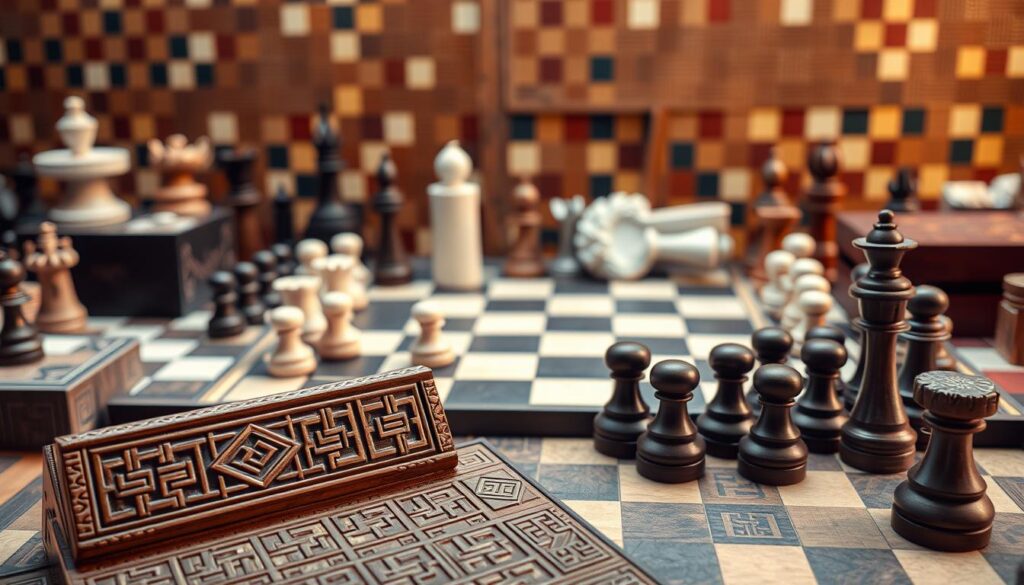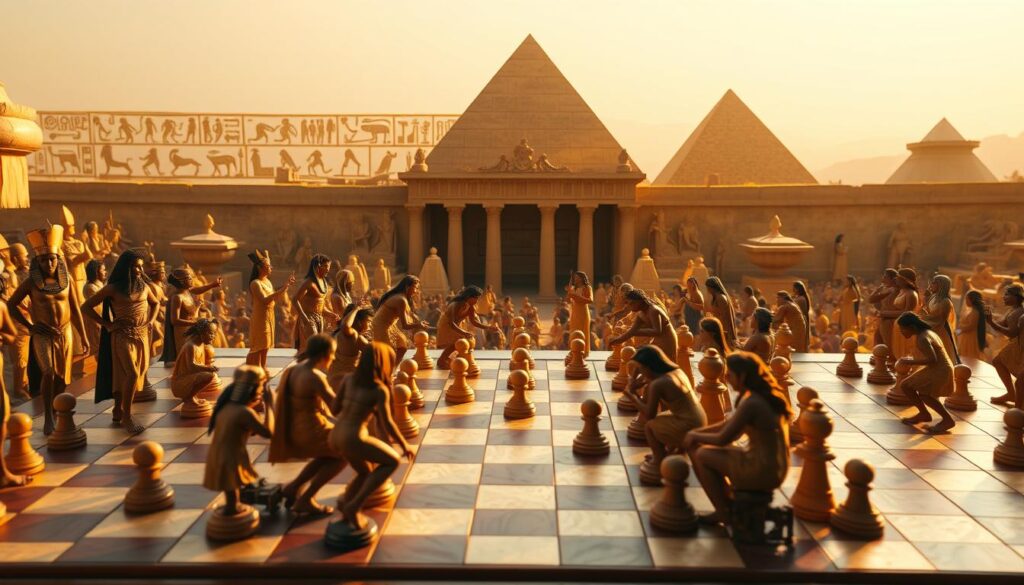
The game of checkers has a long history, starting from ancient Egypt. It’s a story of how a simple game evolved over time. Today, checkers is a classic enjoyed by many, across different ages and backgrounds.
Checkers has roots in ancient board games. It shows how a simple game can unite people across cultures and time. Its strategic gameplay has made it a favorite in many homes, with its own rich history.

We’ll explore checkers’ ancient beginnings, global versions, and cultural impact. From ancient Egypt to today, the game has changed a lot. Its history shows how games can connect people, leaving a lasting impact on our culture.
Introduction to Checkers
The history of checkers is a captivating tale that spans millennia. As we dive into checkers, we’ll see how it evolved from ancient games to today. With its deep history and cultural importance, checkers is loved worldwide.
Key Takeaways
- The game of checkers has a rich history that spans thousands of years.
- Checkers originated from ancient board games in Egypt.
- The game has undergone significant changes over time, shaped by the people who played it.
- Checkers has become a timeless classic, enjoyed by people of all ages and backgrounds.
- The game’s simple yet strategic gameplay has made it a staple in many households.
- Checkers history is a testament to the power of games to bring people together.
Ancient Origins: The Birth of Checkers in Egyptian Civilization
The history of checkers starts with ancient Egyptian games. A game called Senet dates back to around 3000 BCE. It was played on a rectangular board with 30 squares.
Senet was a game of strategy and luck. It was enjoyed by everyone, from peasants to pharaohs. This shows how much people loved playing it.
Senet was also important in religious rituals. It was believed to guide the deceased through the afterlife. Tomb paintings and artifacts show Senet’s role in Egyptian culture.
The game’s evolution into a popular game shows the ancient Egyptians’ creativity. They made a complex game into something fun for everyone.
- A rectangular board with 30 squares
- A game of strategy and luck
- Played by people from all walks of life
Senet’s features show its complexity and appeal. It was loved by all in ancient Egyptian society. Studying checkers origins and Egyptian games gives us a peek into ancient Egypt’s culture and traditions.
The Fascinating History of Checkers Through Medieval Times
As the Roman Empire grew, checkers spread across Europe. It became a favorite game among the nobility. The game changed a lot during the Middle Ages.
New pieces, like the king, and rules, like jumping over pieces, were added. This was a big step in the checkers evolution. It showed how the game fit into medieval Europe’s culture and society.
Medieval checkers became even more popular. People played it in taverns, castles, and homes. Players from all walks of life enjoyed its simple yet strategic gameplay.
The game’s easy-to-play nature and appeal helped it spread across the continent. Different areas developed their own versions and rules.
- Introduction of new pieces, such as the king
- New rules, such as capturing pieces by jumping over them
- Increased popularity among the nobility and general population
These changes made the game even more popular. They helped it evolve over the centuries. As it spread, it changed to fit each region’s culture and society.
Global Variations and Cultural Impact
The game of checkers has changed a lot as it spread around the world. Now, we see many global variations of checkers. Each place has its own way of playing, showing off local culture and history.
In Europe, the game got even more interesting. New rules and pieces were added. This led to different regional checkers games, each with its own rules and strategies. The game’s many versions show how it has been shaped by different cultures and histories.

- American checkers: known for its simple rules and fast-paced gameplay
- International draughts: played on a larger board with more complex rules
- Turkish checkers: features a unique set of rules and pieces
These changes show how the game has grown and become loved by people everywhere. By looking into the global variations of checkers and regional checkers, we learn more about its cultural importance and why it’s so popular.
Modern Developments and Competitive Play
Checkers has changed a lot in recent years. Now, we have competitive checkers and tournaments. These changes have brought new rules and variations, making the game exciting for everyone.
Online checkers platforms have played a big role in this growth. They let players from all over the world compete. This has created a community of checkers fans. Now, tournaments are more common, with players competing for prizes.
Modern competitive checkers has some cool features:
- Players use opening traps and endgame maneuvers for advanced strategies.
- New variants like three-dimensional checkers and blind checkers have been developed.
- Technology, like computer-assisted analysis and online streaming, has improved the game.
As checkers keeps evolving, we can expect even more new ideas. Its mix of simplicity and strategy makes it a favorite game. Checkers tournaments and competitive play will keep growing, attracting more players.
Conclusion: A Timeless Game That Continues to Connect Generations
The history of checkers is fascinating, starting in ancient Egypt and reaching today. It shows how this classic game has captured hearts for ages. It has crossed cultural lines and brought people together, no matter their age.
Checkers’ legacy as a timeless board game is amazing. It began as a religious ritual and now is a favorite pastime. Its simple rules and deep gameplay keep players coming back for more. It’s a game that brings people together, improving social skills and critical thinking.
Looking ahead, checkers will remain a beloved game worldwide. Its appeal comes from its history and cultural importance. It will keep connecting people, showing the power of simple games to unite and enrich lives.
FAQ
- 2 IN 1 BOARD GAME SET – This is AMEROUS latest puzzle board set for adults and kids, the 2 in 1 magnetic chess and check…
- NEW UPGRADED MAGNETIC PIECES – The pieces of our wooden chess and checkers set are magnetic and have excellent stability…
- STANDARD PIECES & BOARDS – Dedicated to providing the most professional products for all board game enthusiasts, the tra…
What is the origin of the game of checkers?
Checkers started in ancient Egypt around 3000 BCE. A game called Senet was played on a 30-square board. It was a mix of strategy and luck.
How did checkers spread throughout the ancient world?
As Egypt grew, Senet spread across the ancient world. Different cultures made their own versions. The game’s lasting popularity is seen in ancient artifacts and writings.
How did checkers evolve during the Middle Ages?
In the Middle Ages, checkers changed a lot in Europe. New rules and pieces, like the king, were added. It became a favorite game in medieval times.
What are some of the global variations of checkers?
Around the world, checkers took on many forms. In Europe, new rules and pieces were introduced. In America, it was called “checkers,” while others called it “draughts.” These changes show how the game adapted to different cultures.
How has checkers evolved in modern times?
Today, checkers is a competitive sport with international events. Its simple yet strategic gameplay appeals to many. Online platforms have made it even more popular, allowing global play.
What is the cultural significance of checkers?
Checkers has a deep cultural history, starting in ancient Egypt. Its spread shows how it adapted to various cultures. It’s a beloved game, enjoyed by many, and connects generations through its timeless appeal.

